Matt Werner's Blog, page 7
September 24, 2012
Highlights from the Eat Real Festival in Oakland
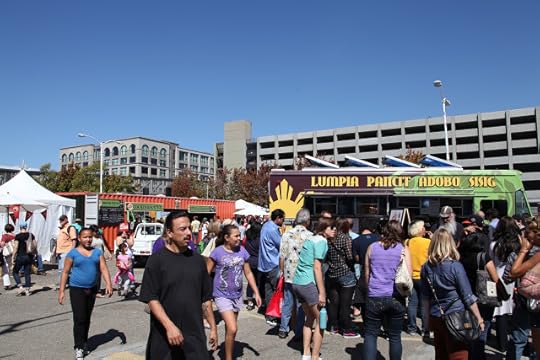 The three-day Eat Real Festival brought out thousands to Jack London Square to eat real food and learn food-making crafts. With temperatures in the mid-70s on September 21-23, ice cream was one of the most popular items, but the all-day festival had dozens of food trucks featuring every type of food one could want--from Hawaiian, to American mac and cheese, to Asian fusion food. In addition to food, there was live music, and indoor DIY exhibits on everything from butchery to making sourdough. Also, many East Bay shops were selling jam, chocolate, and other locally-made food in an indoor market.
The three-day Eat Real Festival brought out thousands to Jack London Square to eat real food and learn food-making crafts. With temperatures in the mid-70s on September 21-23, ice cream was one of the most popular items, but the all-day festival had dozens of food trucks featuring every type of food one could want--from Hawaiian, to American mac and cheese, to Asian fusion food. In addition to food, there was live music, and indoor DIY exhibits on everything from butchery to making sourdough. Also, many East Bay shops were selling jam, chocolate, and other locally-made food in an indoor market.Walking between food trucks, I smelled fried lumpia, Indian curries, and tacos. I heard the humming of small generators strapped to the front of the food trucks, and the sound stage in the background. It was cramped during Saturday afternoon, with swarms of parents and children, and people gingerly navigating their bikes through lines people craving paella and BBQ.
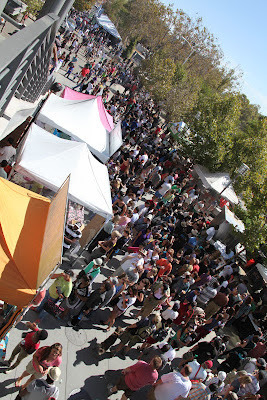 The event website billed the event as featuring: "Tacos inspired by flavors from around the world, curry, BBQ, hot dogs, ice cream, noodles, and a whole lot more of the Bay Area's awesome curbside eats. The Eat Real Festival celebrates all things tasty, fresh, and handmade with a focus on street food, local wines, handcrafted beers, and traditional food craft – all featuring sustainable, local ingredients. And no dish costs more than $5."
The event website billed the event as featuring: "Tacos inspired by flavors from around the world, curry, BBQ, hot dogs, ice cream, noodles, and a whole lot more of the Bay Area's awesome curbside eats. The Eat Real Festival celebrates all things tasty, fresh, and handmade with a focus on street food, local wines, handcrafted beers, and traditional food craft – all featuring sustainable, local ingredients. And no dish costs more than $5." The low prices encouraged people to try several different food stands. Overwhelmed with so many options, I picked three meals at random:
The low prices encouraged people to try several different food stands. Overwhelmed with so many options, I picked three meals at random:Pulled pork slider with habanero hot sauce with a side of roasted corn and pork rinds from Jim 'N Nick's Bar-B-Q.Organic vegetable bowl from Plum Oakland.Hand-dipped corn dog from Tante’s Catering.Each meal was exquisite and piping-hot. My only regret was that after the corn dog, I was so full, that I couldn't eat any more. To get a sense of the magnitude of how many food options there were at the event, see the detailed festival reviews on Yelp.
 Also at the event near Jack London's cabin were outdoor talks on where local fish are caught, and tables for food justice organizations like the People's Grocery in West Oakland. Speaking with Raheemah Nitoto, a nutrition consultant, who was offering a free dietary analysis at the event, she spoke of the food deserts in East and West Oakland and the difficulty of getting nutritious food in those areas largely populated with liquor stores. Her perspective shed light on the many in need in Oakland, and how poor eating habits can lead to obesity, heart disease, and diabetes.
Also at the event near Jack London's cabin were outdoor talks on where local fish are caught, and tables for food justice organizations like the People's Grocery in West Oakland. Speaking with Raheemah Nitoto, a nutrition consultant, who was offering a free dietary analysis at the event, she spoke of the food deserts in East and West Oakland and the difficulty of getting nutritious food in those areas largely populated with liquor stores. Her perspective shed light on the many in need in Oakland, and how poor eating habits can lead to obesity, heart disease, and diabetes.In all, the festival represented the many local food vendors, and people from throughout the East Bay came to enjoy the sunshine and to eat tasty, healthy food.
Click here for photos from the event.
By Matt Werner, author of Oakland in Popular Memory. Email Matt at editor[at]thoughtpublishing.org. This post is cross-published to Oakland Local.
Published on September 24, 2012 23:43
September 23, 2012
From Train Stations to Pot Dispensaries: Old Oakland Walking Tour is full of surprises
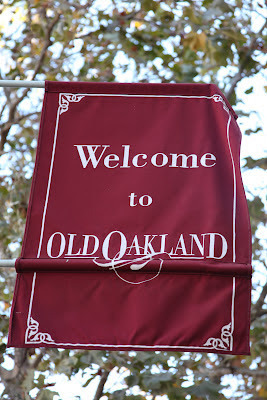 "I must warn you before we begin: I'm an unapologetic Oakland snob," said Don Tyler, a former Oakland High School history teacher, as we began the walking tour of Old Oakland. A group of twenty gathered for the City of Oakland walking tour at G.B. Ratto & Co. International Grocers, one of the oldest family-owned businesses in Oakland, California. Many of the tour attendees had lived in Oakland for quite some time, but wanted to learn more about what it was like before 1906 and when it was a frontier town. Tyler referred to San Francisco as the "West Bay" and preferred to call the East Bay by a more-fitting name: "the continental side of the Bay."
"I must warn you before we begin: I'm an unapologetic Oakland snob," said Don Tyler, a former Oakland High School history teacher, as we began the walking tour of Old Oakland. A group of twenty gathered for the City of Oakland walking tour at G.B. Ratto & Co. International Grocers, one of the oldest family-owned businesses in Oakland, California. Many of the tour attendees had lived in Oakland for quite some time, but wanted to learn more about what it was like before 1906 and when it was a frontier town. Tyler referred to San Francisco as the "West Bay" and preferred to call the East Bay by a more-fitting name: "the continental side of the Bay."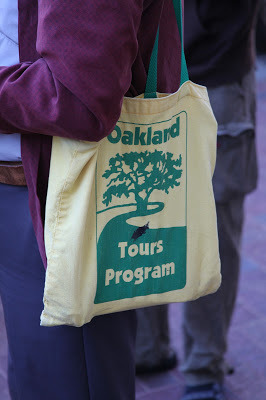 The tour focused primarily on the architectural history of Oakland's oldest storefronts from the 1860s and 1870s. But far from being a tedious architectural tour, Tyler weaved in stories about the personalities of Oakland's early powerbrokers, some of whom had delusions of grandeur and Kanye-West-sized egos. These historic figures have had a lasting effect on Oakland, naming streets after themselves and also having lasting impacts, like creating the Key System for public transit and bringing the western terminus of the transcontinental railroad to Oakland.
The tour focused primarily on the architectural history of Oakland's oldest storefronts from the 1860s and 1870s. But far from being a tedious architectural tour, Tyler weaved in stories about the personalities of Oakland's early powerbrokers, some of whom had delusions of grandeur and Kanye-West-sized egos. These historic figures have had a lasting effect on Oakland, naming streets after themselves and also having lasting impacts, like creating the Key System for public transit and bringing the western terminus of the transcontinental railroad to Oakland. Walking through 7th, 8th, and 9th Streets in Downtown Oakland, tour participants saw the buildings used for one of Oakland's early industries--shipping produce from Fruitvale across the U.S. Tyler also addressed the effect of the mass migration from San Francisco after the 1906 earthquake and fire, when Oakland exploded from 66,000 people in 1900 to 150,000 people in 1910. Don Tyler also told stories of famous dancer Isadora Duncan, and writers Jack London and Gertrude Stein, who were contemporaries at Oakland High School.
Walking through 7th, 8th, and 9th Streets in Downtown Oakland, tour participants saw the buildings used for one of Oakland's early industries--shipping produce from Fruitvale across the U.S. Tyler also addressed the effect of the mass migration from San Francisco after the 1906 earthquake and fire, when Oakland exploded from 66,000 people in 1900 to 150,000 people in 1910. Don Tyler also told stories of famous dancer Isadora Duncan, and writers Jack London and Gertrude Stein, who were contemporaries at Oakland High School.He had colorful tales about the Oakland pioneers who dreamed big, like Borax Smith who had a ballroom in his Oakland mansion that could fit 3,000 people, and one of the largest organs West of the Mississipi in his entranceway. Using the early architecture as a focal point, Tyler weaved in how the railroad came to dominate local politics, and how Governor George Pardee (whose house is in Old Oakland) was one of the first non-railroad governors of California. He recounted Pardee's clashes with the Southern Pacific Railroad over control over the Port of Oakland.
 One of the tour guide's stories that has particular relevance to today was Tyler's story of Samuel Merritt. Merritt bought land in Oakland in the 1850s and 1860s and built houses around the tidal slough and dammed it to create in what we know of today as Lake Merritt. However, Merritt didn't want people hunting waterfowl near his new exclusive houses, so he worked to get the area protected as America's first wildlife refuge. Scholars point to this as a precursor to the National Park system. This historical record is relevant to today because the Lake Merritt Master Plan is under way to reopen the Lake Merritt to allow water to flow to and from the Bay and allow fish and animals from the Bay to enter Lake Merritt.
One of the tour guide's stories that has particular relevance to today was Tyler's story of Samuel Merritt. Merritt bought land in Oakland in the 1850s and 1860s and built houses around the tidal slough and dammed it to create in what we know of today as Lake Merritt. However, Merritt didn't want people hunting waterfowl near his new exclusive houses, so he worked to get the area protected as America's first wildlife refuge. Scholars point to this as a precursor to the National Park system. This historical record is relevant to today because the Lake Merritt Master Plan is under way to reopen the Lake Merritt to allow water to flow to and from the Bay and allow fish and animals from the Bay to enter Lake Merritt.Tyler highlighted the architectural history of two buildings in particular. The popular pub The Trappist is in a Victorian from the 1870s, and it's next to the oldest two-story masonry building in Oakland, the Sanford Building built in 1865. It now houses the Starbucks on the corner of 8th and Broadway.
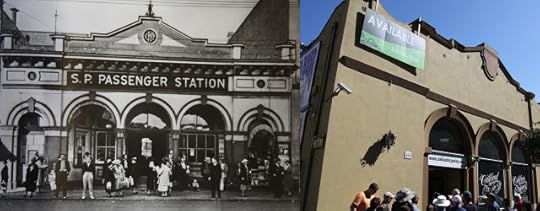 Central Pacific Railway Depot then and now. The former terminus of the transcontinental railroad is now a medical marijuana dispensary.And the original terminus of the transcontinental railroad is now where the Oakland Police station is located at 7th and Broadway. In an interesting twist of history, the old Cental Pacific Railway Depot at 464 7th Street now houses a medical marijuana dispensary called Oakland Organics. If you compare the historic photo to present-day, you can see the arches from the old train building.
Central Pacific Railway Depot then and now. The former terminus of the transcontinental railroad is now a medical marijuana dispensary.And the original terminus of the transcontinental railroad is now where the Oakland Police station is located at 7th and Broadway. In an interesting twist of history, the old Cental Pacific Railway Depot at 464 7th Street now houses a medical marijuana dispensary called Oakland Organics. If you compare the historic photo to present-day, you can see the arches from the old train building.To find out more about the walking tours going from now until October, see Oakland Walking Tours.
Click here to view photos from the Old Oakland Walking Tour.
Published on September 23, 2012 22:05
September 16, 2012
Michael Chabon’s Real and Imagined Storefronts
 Jorge Luis Borges wrote fake book reviews of books that didn’t exist. Michael Chabon has taken this postmodern literary conceit beyond Borges. Chabon has not only written fan fiction based on his own writing, but he’s created stores from his fiction in real-life. Take for example Diesel bookstore in Oakland which was converted to Brokeland Records.
Jorge Luis Borges wrote fake book reviews of books that didn’t exist. Michael Chabon has taken this postmodern literary conceit beyond Borges. Chabon has not only written fan fiction based on his own writing, but he’s created stores from his fiction in real-life. Take for example Diesel bookstore in Oakland which was converted to Brokeland Records.This fictional record store has replaced the independent bookstore from September 7-14 to correspond with the release of Michael Chabon’s latest novel, Telegraph Avenue. Chabon opening Brokeland Records goes beyond book marketing. It’s an interesting addition to postmodern literary experimentation, in that it raises the question, What happens when a fictional store you’re writing about, becomes real? And this isn’t the first store to be created from Chabon’s fictional work. The Escapist comic bookstore on Claremont Avenue in Berkeley is named after Chabon’s comic creation The Escapist from The Amazing Adventures of Kavalier & Clay.
Read the full post on the Diesel Book Store blog
Published on September 16, 2012 22:12
September 10, 2012
Endless Canvas opens a 'Sistine Chapel' of graffiti art in Berkeley
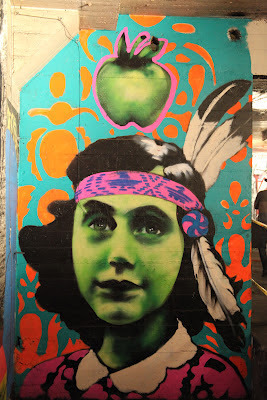 Thousands turned out Saturday night, September 8, 2012 for the Endless Canvas graffiti warehouse opening in Berkeley, California. This underground event called Special Delivery Bay Area 2012, despite being covered by very few local press outlets, grew to be the most popular art event in the East Bay Saturday night. It featured street art from over 80 local graffiti artists who covered nearly every inch of a 36,000-square-foot warehouse with graffiti and street art.
Thousands turned out Saturday night, September 8, 2012 for the Endless Canvas graffiti warehouse opening in Berkeley, California. This underground event called Special Delivery Bay Area 2012, despite being covered by very few local press outlets, grew to be the most popular art event in the East Bay Saturday night. It featured street art from over 80 local graffiti artists who covered nearly every inch of a 36,000-square-foot warehouse with graffiti and street art.The organizers were surprised with the masses of people who showed up, posting on their website the day after: "we didn’t think that many people would show up." Perhaps the mystique of the event was heightened because the location of the warehouse was kept secret until the day before the event, leaving people to speculate about where the warehouse could be. There's nothing like secrecy, controversy, and rumors of art depicting illicit things to bring out thousands to an East Bay art event.
What attendees found in the former Flint Ink building at 1350 4th Street (a warehouse vacant since 1999), was a building transformed by graffiti artists into what Sean Hanlon, an Oakland resident, called "a Sistine Chapel of graffiti art." Not only were the walls covered with spray paint, but also the floor, ceiling, stairwells, and even elevator shaft.
 It was not just tags and gang signs, but inside were works of art, like a Vincent Van Gogh portrait redrawn with a third eye, and Anne Frank in a headress with an apple floating above her--a reference to Belgian surrealist painter René Magritte. The artists took pains to integrate the warehouse's granite-like concrete walls riddled with airshafts, windows, balconies, and staircases into their multi-story art pieces. Some artists also tackled political topics, like a mural featuring Fox News, depicting the White House under attack by UFOs, and another on the role of street artists and public dissent.
It was not just tags and gang signs, but inside were works of art, like a Vincent Van Gogh portrait redrawn with a third eye, and Anne Frank in a headress with an apple floating above her--a reference to Belgian surrealist painter René Magritte. The artists took pains to integrate the warehouse's granite-like concrete walls riddled with airshafts, windows, balconies, and staircases into their multi-story art pieces. Some artists also tackled political topics, like a mural featuring Fox News, depicting the White House under attack by UFOs, and another on the role of street artists and public dissent.In addition to artwork by over 80 local street artists, entertainment was provided by local hip hop and dance groups. As the sun went down, floodlights were turned on to illuminate the walls, and the crowds only grew as the hours went on. Between 6-7pm, there was no line to get into the event. But by 9:30pm, the line stretched 2 blocks.
 Informally polling people in line about how they heard about the event, most people said they found out about Special Delivery Bay Area through social media outlets like Facebook and Tumblr. Others said they read about it in the East Bay Express and SF Fun Cheap. A street art enthusiast in line said he attended Special Delivery, a similar street art exhibit in Portland, Oregon in July, 2011, and heard about this event through Endless Canvas.
Informally polling people in line about how they heard about the event, most people said they found out about Special Delivery Bay Area through social media outlets like Facebook and Tumblr. Others said they read about it in the East Bay Express and SF Fun Cheap. A street art enthusiast in line said he attended Special Delivery, a similar street art exhibit in Portland, Oregon in July, 2011, and heard about this event through Endless Canvas.The Berkeley warehouse looks similar to Kunsthaus Tacheles in Berlin, Germany, except this one has even more graffiti covering every inch of the interior. Read more about how Alan Varela came to host the Special Delivery Bay Area 2012 art show in the East Bay Express.
Click here for photos of the art exhibit.
---
By Matt Werner, author of Oakland in Popular Memory. Email Matt at editor[at]thoughtpublishing.org.
Published on September 10, 2012 01:52
September 7, 2012
Joaquin Miller: Oakland's first hipster?
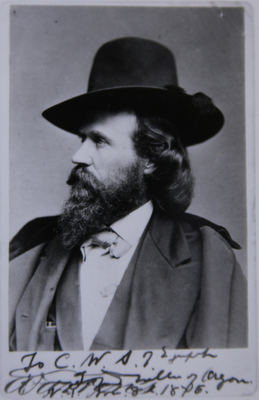 Joaquin Miller (Courtesy Oakland Public Library, Oakland History Room.)Over the past year, I’ve overheard Oakland natives complaining about the influx of hipsters moving to Oakland. However, this trend is as old as the city itself. Poseurs have been coming to the East Bay since the pioneer days. Today we honor one of these famous poseurs, Joaquin Miller, on his 175th birthday.
Joaquin Miller (Courtesy Oakland Public Library, Oakland History Room.)Over the past year, I’ve overheard Oakland natives complaining about the influx of hipsters moving to Oakland. However, this trend is as old as the city itself. Poseurs have been coming to the East Bay since the pioneer days. Today we honor one of these famous poseurs, Joaquin Miller, on his 175th birthday.Joaquin Miller was known as the “Poet of the Sierras,” and lived in a white cottage he called “The Abbey” in the Oakland hills from 1886 to his death in 1913. He earned his fame as an eccentric poet who told tall tales, and as a fashion icon. His house and hillside monuments now make up Joaquin Miller Park.
Read the full post about this Oakland fashionista on the Oaklandish blog
Published on September 07, 2012 18:51
Oakland in Popular Memory now at 25th Street Collective
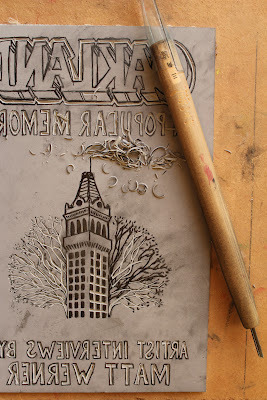 Oakland in Popular Memory cover carved in a linoleum block by Dave SmallenOakland in Popular Memory is now available at the 25th Street Collective. Stop by 477 25th Street Oakland, California tonight (September 7) for the First Friday Art Murmur between 6-10pm to purchase a copy of the book.
Oakland in Popular Memory cover carved in a linoleum block by Dave SmallenOakland in Popular Memory is now available at the 25th Street Collective. Stop by 477 25th Street Oakland, California tonight (September 7) for the First Friday Art Murmur between 6-10pm to purchase a copy of the book.You can also check out the 25th Street Collective during the Saturday Stroll, which happens from 1-5pm every Saturday afternoon. The book is in the front of the warehouse, just to the right when you enter the door.
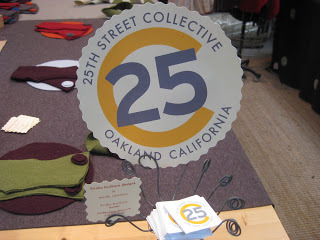
Published on September 07, 2012 18:41
August 20, 2012
Pedalfest celebrates all things bikes in Oakland
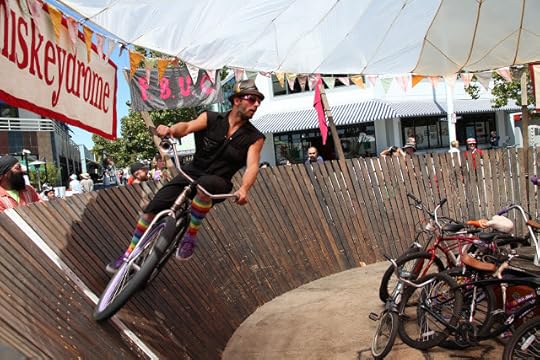 Pedalfest lived up to its billing as one of the "biggest celebrations of the bicycle in regional history." An estimated 20,000 people attended Pedalfest at Jack London Square on Saturday, August 18, 2012.
Pedalfest lived up to its billing as one of the "biggest celebrations of the bicycle in regional history." An estimated 20,000 people attended Pedalfest at Jack London Square on Saturday, August 18, 2012.The cycling extravaganza and street fair at Jack London Square boasted many highlights, including a bicycle rodeo, bike parade, folding bike races, WhiskeyDrome (a mini-velodrome), and the Clayton Bikes Stunt Team doing backflips and other X Games-style stunts.
 Bicycle enthusiasts from all skill levels were in attendance, and some brought one-of-a-kind concept bikes.
Bicycle enthusiasts from all skill levels were in attendance, and some brought one-of-a-kind concept bikes. There were also plenty activities for kids, such as a bike obstacle course and experimental bikes for kids to ride. The event went from 11am to 8pm, and already by early afternoon, thousands were in attendance, going to the vendor's booths and listening to live music.
There were also plenty activities for kids, such as a bike obstacle course and experimental bikes for kids to ride. The event went from 11am to 8pm, and already by early afternoon, thousands were in attendance, going to the vendor's booths and listening to live music.Click here for photos of the event on Google+
By Matt Werner, author of Oakland in Popular Memory. Email Matt at editor[at]thoughtpublishing.org. This post is also cross-posted to Oakland Local.
Published on August 20, 2012 09:59
August 14, 2012
In Defense of Oakland
The following is my introduction to Oakland in Popular Memory, which I read an excerpt of in my Authors@Google talk.
In Defense of Oakland
When I was an undergraduate at UC Berkeley, I remember talking with a sorority girl at a party about where we grew up. She was from Orange County. I replied that I was born in Oakland, California, and I grew up in Alameda, Oakland, Berkeley, and Palo Alto.
She stared at me in disbelief. One word stood out to her. “Oakland? Oh, we don’t go into Oakland.”
When I prodded her some more, she said that Oakland was so violent, and that there were so many murders, that her parents warned her never to go into Oakland. Eventually, I got her to admit that she goes to Zachary’s Pizza only a couple miles south of UC Berkeley and to Fentons Ice Creamery. But she insisted that she didn’t venture any further into Oakland than Fentons.
It was clear that the mere mention of “Oakland” triggered something of a fear response in her.
Her use of the word “into” was also very telling. In a sense, that one little word reflected not only her fear but many people’s ambivalence toward Oakland as well. It was as if the locales of Zachary’s and Fentons—upper middle class neighborhoods—were not part of Oakland but extensions of Berkeley, and that the idea of venturing any farther “into” Oakland was unfathomable.
This encounter has stayed with me because, for the first time, I began to consider Oakland through the eyes of an “outsider.” This encounter is representative of the many I’ve had since, and these misperceptions motivated me to offer a different narrative of Oakland. The Oakland I’ve grown up in has its challenges like any major city, but what stands out to me is the cultural renaissance happening in Oakland today. I’ve been privileged to have a front-row seat to see what’s been happening in Oakland, and I wrote Oakland in Popular Memory to collect my interviews with the people who know it best—musicians and writers from Oakland and those shaping its art scene.
Wanting to better understand the outsider’s perspective of Oakland, I wondered, why do even reputable outlets like the Discovery Channel air sensationalistic programming about Oakland? They have two shows called Gang Wars: Oakland and Gang Wars II: Oakland , which follow the Oakland Gang Task Force.
 The first episode begins with a deep voice-over calling Oakland, California “ground zero in a new American war. Violent street gangs fight over drug turf, and the battle is only escalating.” Oakland is called a “war zone” and it’s compared to Iraq, adding to the already sensational tone. This gives viewers the impression that just below the surface, Oakland is fomenting with such violence, that at any moment all hell will break loose.
The first episode begins with a deep voice-over calling Oakland, California “ground zero in a new American war. Violent street gangs fight over drug turf, and the battle is only escalating.” Oakland is called a “war zone” and it’s compared to Iraq, adding to the already sensational tone. This gives viewers the impression that just below the surface, Oakland is fomenting with such violence, that at any moment all hell will break loose.With this much negative press, it’s no wonder people are afraid to go into Oakland. Given the presuppositions and stereotypes that result from such portrayals it’s hard for visitors to experience the reality of what is presented before them because it clashes with the narrative they’ve internalized from countless news reports. People consuming this type of media go to Oakland expecting to find drive-by shootings, roving gangs toting AK-47s, as well as pimps, prostitutes, and race riots. However, people visiting Oakland are often surprised when they don’t see this, but instead find several avant-garde movements in art, music, fashion, urban farming, and local food.
Chinaka Hodge, an Oakland writer, whom I was fortunate to interview for Oakland in Popular Memory, writes about the perceptions of Oakland in her blog:
“I lived on the East Coast for a few years. Tell a New Yorker you’re from Cali, and they’ll assume, 8 times out of 10, that you’re from Los Angeles. I live in LA now. Tell the average Angeleno that you’re from up North, and they assume San Francisco. Oakland is constantly upstaged, asterisked and misunderstood. In my travels, I still field questions about the 1996 Ebonics debate; I talk about a hoop squad that is more than Latrell’s hands around someone’s neck; I remind that we are more than the riots that followed the Raiders’ loss at the 2003 Superbowl.”
Hodge continues, setting the record straight about what Oakland is and what the city does best.
“In short, Oakland is Proud because no one else will be proud for us. We exercise a rich cultural legacy, a policy of introspection and a knack for finding the next. The Town is a study in surprise, in artistic innovation, in movements foreign to the rest of the planet. We are the birthplace of leather jackets rocked with berets at free breakfast, where Skyline High School taught Tom Hanks to act, the original terminus for all Pullman Porter activity, where Walt Disney visited a theme park near a lake and began drafting ideas for Disneyland. Here, we make ideas that power the world. We do what no one else does, and we do it well.”
Hodge’s poetic description giving snapshots of various periods of Oakland’s history captures Oakland’s free-spirited character that is at once tough, artistic, and even sensitive—a character often misunderstood. But Oakland is unapologetic. After all it knows who it is: a strong city, that’s gracious and accepting of people from all economic and cultural backgrounds.
Oakland residents are resilient, free-spirited, and confident, qualities which keep the city at the cutting edge and help it forge trends in fashion, music, dance, or as Hodge puts it, making “ideas that power the world.” These ideas are indeed powerful as they go beyond individual expression and often speak to the collective soul of a generation or a group of people. Oakland mediates the production of art, language, and cultural innovation for the US and has produced some of the country’s top talent.
Despite only having 400,000 residents, several iconic cultural figures grew up in Oakland, including Gertrude Stein, Clint Eastwood, and Tupac Shakur. It’s a mecca for hip-hop, producing artists like MC Hammer, Too Short, Mac Dre, Keak da Sneak, Mistah F.A.B., and Del the Funky Homosapien. Oakland is also the birthplace of many rock groups and members of bands like: Green Day, REM, and Third Eye Blind. Oakland has a long history of producing leading jazz, funk, and R&B artists like Keisha Cole and En Vogue, and older bands like Tower of Power, The Pointer Sisters, and Tony! Toni! Toné! Although this book won’t cover these famous figures, Black Artists in Oakland by Jerry Thompson and Duane Deterville, does an excellent job at portraying Oakland’s arts heritage.
Why is the perception of Oakland at odds with its role as a culture creator? Gang Wars: Oakland features interviews from prison with Oakland’s most violent Latino gang members. They’re in orange jump suits, arms covered in tattoos, and on the show they talk about who they’ve shot or stabbed and how they won’t hesitate to use violence again if they have to defend their honor.
These violent images reinforce what Oakland author Ishmael Reed calls the “If it bleeds, it leads” style of reporting on Oakland. In his book Blues City: A Walk in Oakland , Reed criticizes how the press fixates on violence in Oakland while consistently neglecting much of Oakland’s vibrant cultural happenings. In fact, mainstream media often portrays West Oakland as a landscape similar to the Grand Theft Auto San Andreas video game, overrun with gangsters and drug addicts.
However, the city is bustling with activity from the annual Life is Living Festival in DeFremery Park, the Oakland dance group Turf Feinz dancing on streetcorners in videos made famous by Yak Films, and many incredible food joints like Bakesale Betty, where people line up for half a block on Saturday afternoons to get her famous fried chicken sandwiches, and sit down to eat them at ironing boards repurposed as tables.
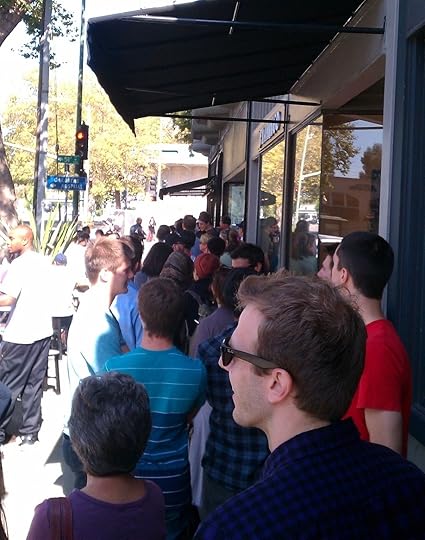
Line outside Bakesale Betty for her famous fried chicken sandwiches
The local food movement spans from fine dining experiences like Commis, run by Oakland-native James Syhabout, which earned Oakland its first Michelin Star in 2009. To people growing their own food in their yard in an urban farming movement led by Novella Carpenter, author of Farm City and co-author of The Essential Urban Farmer with Willow Rosenthal.
Oakland: The secret is out
Ishmael Reed wrote in Oakland Rhapsody: The Secret Soul of an American Downtown in 1995 that “Oakland is America’s best kept secret.” Well, the secret is out. And the media is starting to take notice: The New York Times ranked Oakland as one of the top-5 places to visit in the world in 2012.
The New York Times Travel section gives credit to Oakland native chef James Syhabout, but it also points out that Oakland is now worth visiting because famous San Francisco chefs have decided to set up shop in Oakland. But it’s not only such entrepreneurial transplants that make Oakland worth visiting.
Those in the know would say the media’s recognition of Oakland’s thriving cultural realm was long overdue, especially given the city’s growth spurt in the art, music, fashion, and literary scenes in the last decade. In the last few years alone, over a dozen new art galleries have popped up in Oakland’s Northgate-Waverly district, previously known for its auto repair shops and warehouses. Such a renaissance no doubt draws inspiration from Oakland’s rich history as a cultural destination since the late 19th century, hosting the likes of Gertrude Stein, Jack London, Mark Twain, Robert Louis Stevenson, and John Muir, to name a few. More recently, Oakland gave birth to the Hyphy Movement, the Scraper Bike movement, and turf dancing, while Mac Dre, E-40, and Keak da Sneak invented much of the hip-hop language used internationally today.
Several local news sources have sprung up in recent years to document this renaissance in art collectives, local food movement, urban farming, and music, including Oakland Local , Oakland North , The Bay Citizen , GoBanter , Thizzler , and 38th Notes .
The Bay Area’s indie and underground scenes are constantly “studies in surprise.” They’ve historically been engines of innovation, creating new musical styles and language. What’s happening on the ground today in the Bay may take months or even years to become “mainstream.”
Novelist William Gibson said “The future is already here — it’s just not very evenly distributed.” In the Bay Area, the future in music and language is already here. Each artist I interviewed in Oakland in Popular Memory is innovating in his or her own way. You can listen to the future of music through these artists. These twelve established and up-and-coming artists give perspectives on Oakland different from the usual media narrative about the city. What I admire about these artists is how they’ve kept their authenticity as they’ve grown in their music and how they champion the Oakland quality of having a “knack for finding the next.”
And as for the sorority girl at the beginning, I hope she visited Oakland while she was at UC Berkeley. If not, she sure missed out on a lot.
---By, Matt Werner, author of Oakland in Popular Memory: Interviews with 12 cutting-edge artists from Oakland and beyond
Published on August 14, 2012 23:23
Authors@Google Talk about Oakland in Popular Memory
I spoke at Google about Oakland in Popular Memory on August 6, 2012 as part of their Authors@Google series. Here's the video:
Published on August 14, 2012 17:18
August 13, 2012
Is Lil B Oakland's new Gertrude Stein?
To join today's trend of applying literary theory to hip hop (like the Economist and the Language Log comparing Lil Jon to Beowulf), here's my addition:
Could Lil B be the Bay Area’s next Gertrude Stein? His play on repetition of words like “swag” and “winning,” is similar to Gertrude Stein’s repetition and modernist wordplay with everyday items and phrases, like she does in her book Tender Buttons and poems like "If I Had Told Him: A Completed Portrait of Picasso."
Stein’s writing emphasized “the sounds and rhythms rather than the sense of words.” In her poetry, she wrote to capture “‘moments of consciousness,’ independent of time and memory.” In a similar fashion, Lil B plays with repetition turning modern catch-phrases and pop culture references into items to be repeated, dissected, and flipped.
Instead of writing about objects, food, and rooms, Lil B raps about Swag, Charlie Sheen, and Ellen Degeneres. This thesis could perhaps be turned into an academic paper by someone studying language poetry or modernist literature.
To listen to these chronologically disparate, but sonic and rhythmically similar styles, listen to Gertrude Stein’s playing with words in “If I Had Told Him” and then listen to Lil B’s Ellen Degeneres.
"If I Had Told Him: A Completed Portrait of Picasso" and Lil B’s repetition of Swag seemed to be incessant on many of his tracks. So much so, that Funny or Die even released a video about Investigating Swag Syndrome.
So what do you think? Is Lil B continuing Gertrude Stein's literary legacy?

Could Lil B be the Bay Area’s next Gertrude Stein? His play on repetition of words like “swag” and “winning,” is similar to Gertrude Stein’s repetition and modernist wordplay with everyday items and phrases, like she does in her book Tender Buttons and poems like "If I Had Told Him: A Completed Portrait of Picasso."
Stein’s writing emphasized “the sounds and rhythms rather than the sense of words.” In her poetry, she wrote to capture “‘moments of consciousness,’ independent of time and memory.” In a similar fashion, Lil B plays with repetition turning modern catch-phrases and pop culture references into items to be repeated, dissected, and flipped.
Instead of writing about objects, food, and rooms, Lil B raps about Swag, Charlie Sheen, and Ellen Degeneres. This thesis could perhaps be turned into an academic paper by someone studying language poetry or modernist literature.
To listen to these chronologically disparate, but sonic and rhythmically similar styles, listen to Gertrude Stein’s playing with words in “If I Had Told Him” and then listen to Lil B’s Ellen Degeneres.
"If I Had Told Him: A Completed Portrait of Picasso" and Lil B’s repetition of Swag seemed to be incessant on many of his tracks. So much so, that Funny or Die even released a video about Investigating Swag Syndrome.
So what do you think? Is Lil B continuing Gertrude Stein's literary legacy?
Published on August 13, 2012 23:15
Matt Werner's Blog
Matt Werner isn't a Goodreads Author
(yet),
but they
do have a blog,
so here are some recent posts imported from
their feed.



